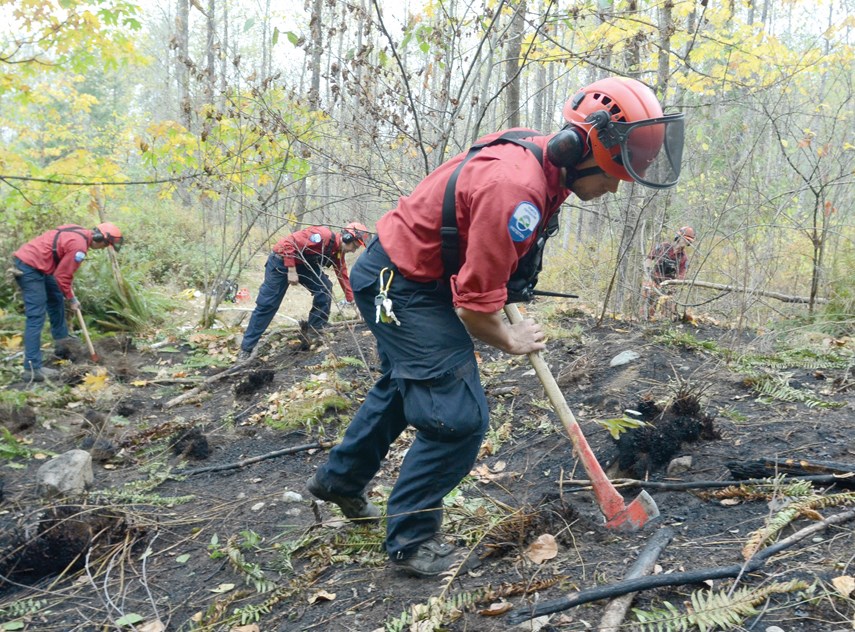The District of North Vancouver is planning to spend $127,000 on wildfire protection – but that may not be enough, according to one councillor.
At their Oct. 2 meeting, district council voted unanimously to devote $127,274 to wildfire prevention on the border between urban and forested land. Those funds are buttressed by $377,905 from the Union of B.C. Municipalities.
The money is earmarked to complete the last two recommendations of the 2007 Community Wildfire Protection Plan, including clearing branches and vegetation that could serve as wildfire fuel from a 17-hectare swath of land bordering Braemar Park, Mountain Highway, St. Mary’s Avenue and Hoskins Road.
When that work is complete, the district will have cleared ladder fuels including small trees, brush and dried branches from 50 hectares. That work would leave approximately 20 hectares still in need of treatment.
The money from the district and the UBCM would also go toward developing a post-fire plan which may be critical in assuaging landslide risks along the district’s steep terrain, according to a district report.
While council was unanimous in supporting those measures, they were somewhat divided over a motion put forward by Coun. Doug MacKay-Dunn that touched on the district’s organic waste pickup policy.
After the district’s new garbage collection system met with complaints from several residents, Coun. Roger Bassam put forward a motion at a September meeting to essentially resume the old system.
The motion was defeated with five councillors, including Coun. MacKay-Dunn, voting against it.
However, in light of the fire risk posed by dumped organics, Coun. MacKay-Dunn suggested council re-examine the issue through the prism of public safety.
“If we don’t pick up the organic waste, where does it go? It can go over banks, it could end up in trails, and certainly it becomes ladder fuel,” he said.
Mayor Richard Walton, as well as Couns. Mathew Bond and Robin Hicks rejected re-opening the organic bin debate.
Waste pickup is an issue unto itself, said Hicks, who suggested MacKay-Dunn’s motion may confuse that issue.
However, MacKay-Dunn did get support from Bassam, who argued organic material deposited in greenbelts can dry out by summertime.
The district will also face flood risks if organic material drifts into catch basins, according to Bassam, who pointed out that people’s behaviour is generally driven by economics.
Reducing fire risks between urban and wildlife areas will likely take a concerted effort, according to Bassam.
“I don’t think we can afford to do this by hiring our own staff and having everyone run around, this looks like it’s going to be a collective effort of all of our citizens cleaning up as best they can on their own interface.”
Removing ladder fuel, while desirable, nonetheless disrupts the life cycle of a forest, Bassam pointed out.
“How often do we have to intervene if we don’t have this natural cycle in effect?” he asked.
While there are ferns and huckleberries growing around Grousewoods today, the forest seemed barren after ladder fuels were removed seven years ago, Walton noted.
“When they took out all that undergrowth it was awful,” he said, explaining workers mitigated the fire risk by removing “dead, spindly things.”
Before fire hazards are removed from a forested area it’s important to notify the neighbourhood, Walton said, explaining that it can take five to 10 years before the area looks verdant again.
Coun. Mathew Bond concurred.
“The immediate effects of the wildfire treatment can be drastic for people that frequent those areas,” he said.
Fire prevention should be a line item in the district’s budget, “so we’re not relying on the generosity of others,” MacKay-Dunn said.
“I would hate to be here a year from now saying, ‘Gosh, I wish we’d done something.’”
With summers expected to be longer, hotter and drier, wildfires are North Vancouver’s “top threat related to climate change,” according to the district climate change adaptation strategy.
District bylaws passed in 2012 mandate that homes in areas at greater risks of wildfires must be built to more stringent construction standards.



